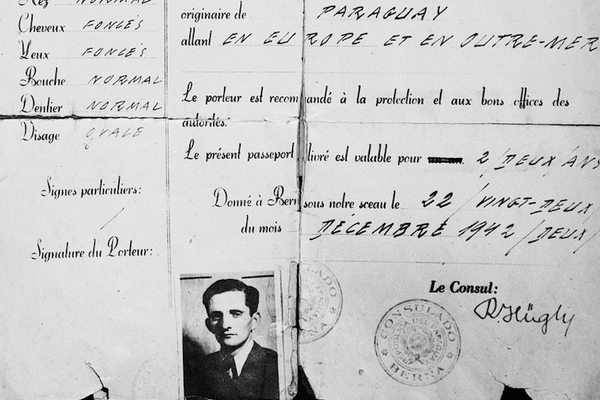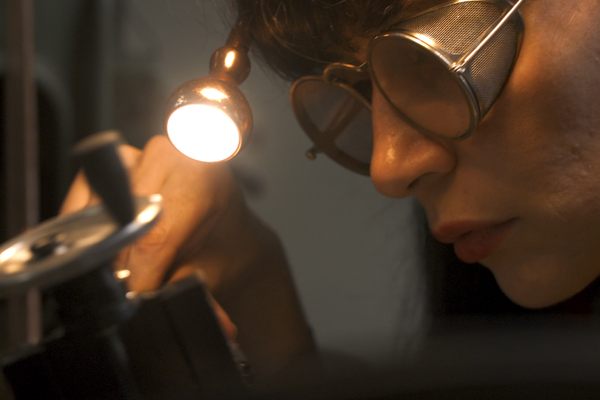The Furniture Fraud That Threw the French Antiques World Into a Furor
Was it an elaborate scam or a highbrow battle of wits?

All it took to uncover the fraud was a lick. Charles Hooreman stood in front of a chair for sale at the exclusive Parisian gallery Didier Aaron in 2012. It had allegedly been the property of Princess Louise Élizabeth, daughter of King Louis XV, but Hooreman was immediately suspicious. He noticed telltale signs of familiar handiwork; his practiced eye could spot many of the techniques used by popular furniture restorers working in Paris at the time, and he knew that one of them used melted licorice to make new wood look older. So he bent down for a lick. “I could taste the fraud,” he later told Vanity Fair.
The man behind the gallery’s furniture collection was one Bill G.B. Pallot—regarded as one of the world’s leading experts of antique French furniture. With his long hair and brightly colored three-piece suits, he cut a distinctive figure in French media and society. His bonafides were unimpeachable: He’d made a career dealing ornate chairs, benches, and other furnishings to galleries, museums, royal families—even the Palace of Versailles. He’d written the book on the subject—The Art of the Chair in Eighteenth-Century France—and taught it at the art history department at the Sorbonne. He was often hired by prestigious companies such as Christie’s auction house to teach or represent the field. And then Hooreman, a former student no less, called him a conman. Four years later, he was arrested.


Now, after eight years of investigation, the highbrow world of French antiques has finally launched its long-awaited courtroom drama. In November 2023, the French courts ordered Pallot to face trial along with five collaborators, including Bruno Desnoues, a highly regarded woodcarver, who allegedly helped him craft a series of chairs that Pallot claimed had once decorated the rooms of Marie Antoinette and King Louis XV’s mistress.
The 138-page referral document for the case, one auction reporter noted, indicates the trail “will certainly be a great spectacle on the dark side of the profession.”
After Hooreman’s suspicions were investigated by French authorities and Pallot was arrested, the Ministry of Culture launched a full audit into the authenticity of the furniture purchased by Versailles and of its buying practices. Hooreman believes that Pallot masterminded more than a dozen fraudulent furniture sales, including some that went on display in museum collections across the globe.
In 2009, four chairs allegedly designed in 1769 by furniture marker Louis Delanois, for King Louis XV’s mistress, were sold to the Palace of Versailles for $1.9 million. At the time, the French Minister of Culture called them “national treasures.” Today, at least two of those chairs are thought to be fakes made by Pallot, in collaboration with the carver Desnoues and a gilder, according to the court case. If these were his first fakes, it appears what started as an experiment became an obsession.

It was not long after the sale that some in the industry suspected something was amiss. William Iselin has been in the business of European antique furniture for the past 40 years, both at Christie’s and as a private dealer and broker. He recalls a time when chairs were appearing on the market, seemingly from nowhere.
The chairs sold to Versailles, and these others that were popping up for sale, were indeed beautiful, but they had no provenance—art dealer parlance for a traceable history. “This is royal furniture and it’s been collected for decades. So you can document most of the pieces—they have some sale history,” says Iselin. “The thing that amazed me about the chairs bought by Versailles is that none of them had any history.”

For Hooreman, Pallot’s former student, it was the quantity of antiquities that tipped him off. The chairs were supposed to have come from a set of 12, crafted for King Louis XV’s palace. Hooreman knew that Versailles already owned six, a Swiss collector had another two, and a Parisian held one. Four more? The numbers didn’t add up.
Tending to the sales was Galerie Kraemer, a multigenerational art house and one of the best regarded in France. Its head, Laurent Kraemer, was arrested alongside Pallot and charged with fraud, which has since been reduced to negligence.
But it was a chauffeur who ended up giving them all away. As the chairs made their way into high society, French police were tipped off that a Paris driver had recently paid cash for a house in Paris and five apartments in Portugal. Under questioning, he admitted that the money had come from Bruno Desnoues, the woodworker, who then told police that he’d earned it producing fake antique furniture for Pallot.

As the story began to emerge and crystallize, museums and collectors scrambled to investigate their own items connected to Kraemer or Pallot. “These are supposed to be the most sophisticated dealers of French furniture,” says Iselin.
There’s something of a tradition among wealthy collectors when faced with the possibility that they’d been duped—silence. Many are too embarrassed to admit it. “The buyers must be willing to ask the questions,” says Iselin. “Some of them don’t. They don’t want to know.”
Now that many of the top-tier players in the fraud have been indicted, potential victims seem more willing to dig into their holdings. Some of Iselin’s clients have hired him to investigate their collections. The wood’s aging, the structure of the furniture, and tool marks are all vital to establishing authenticity. One red flag, for instance, is seamlessly flush seams on old wooden chairs. Over time, wood should retract, leaving minute gaps between the joints. One collection Iselin inspected for a client, which was said to be made by André-Charles Boulle, the 17th-century furniture maker for Louis XIV, he determined to be fake. It’s now the subject of another court case, this one against the brothers who run Galarie Kraemer and four others, for allegedly dealing fake furniture.
So far Pallot has served four months in jail, and though he has admitted guilt, he paints his crime as a battle of wits more than a grab for money. He wanted to see if he could fool the market. “It began as something very philosophical,” he told Vanity Fair. “The first time, it was a stupid joke: ‘Gotcha.’ Nobody sees: the experts don’t see, the curators don’t see, the dealer doesn’t see.”

Without Pallot or Kraemer in the business, and with everyone on high alert for fraud, the French antique furniture market has been dealt a heavy blow. The two pulled out of the prestigious Paris Biennale des Antiquaires art fair, which ended up shuttering in 2021. And in July, a trial began for another prominent antique dealer, Jean Lupu, who was once synonymous with the Biennale. He was found to have a basement full of suspicious stamps and tools, and now stands accused of transforming regular 19th-century furniture into replicas of rare and royal pieces, which he’d sell for millions above their true value.
“It has caused terrible damage to the market by causing people to question the credibility of everybody,” says Iselin. “A few rotten apples have really spoiled things across the board.”
Iselin says that some good has come out of the scandal. Now photographs are carefully taken before and after the restoration of any piece, and provenance is astutely investigated and recorded. There are fewer buyers, but the serious collectors have held their ground. They know that con artists operate in every industry, and it’s their job to not fall for it.
“There are always going to be people who are going to try,” says Iselin. “There’s too much money at stake.”
Nina Strochlic covers stories about migration, conflict, and interesting people across the globe. She was previously a staff writer for National Geographic, Newsweek, and the Daily Beast. She cofounded the Milaya Project, a nonprofit working with South Sudanese refugees in Uganda.




















Follow us on Twitter to get the latest on the world's hidden wonders.
Like us on Facebook to get the latest on the world's hidden wonders.
Follow us on Twitter Like us on Facebook